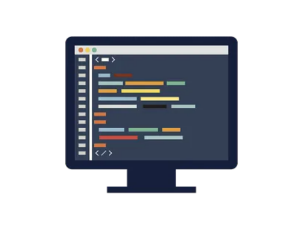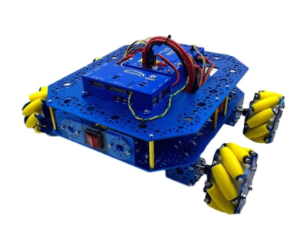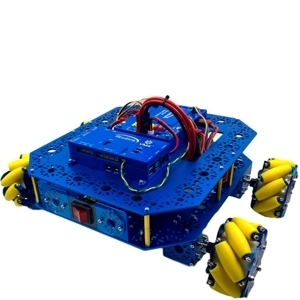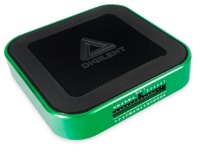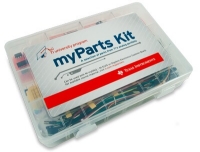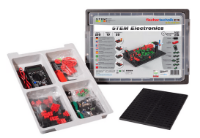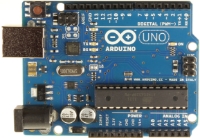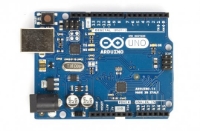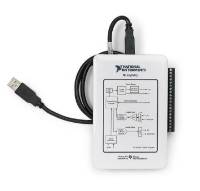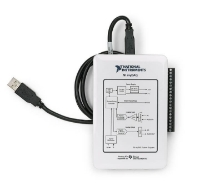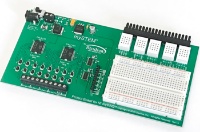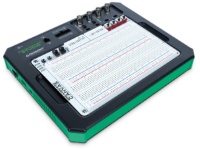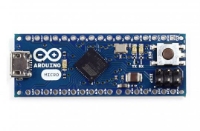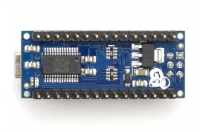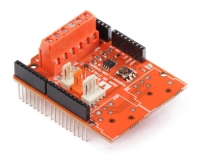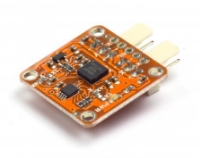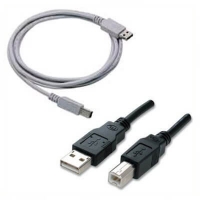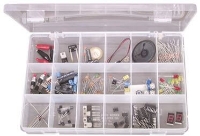Hardware
Hardware
Analog Discovery 3
Discover More with the New Analog Discovery 3 for Education
Digilent’s latest multi-function test and measurement device, also known as the AD3, is a digital oscilloscope, logic analyzer, waveform generator, pattern generator, and much more. Using the flexible WaveForms software (supported by Windows, Mac, and Linux), the Analog Discovery 3 can be used in the lab, in the field, or even at home - you're no longer tied down to a traditional benchtop and stacks of expensive test instruments.
myParts Kit from Texas Instruments: Companion Parts Kit for NI myDAQ
The myParts kit from Texas Instruments comes with a collection of parts that are the building blocks of all electronics, including op-amps, an instrumentation amplifier, a comparator, voltage regulators, switching regulators, digital logic gates, timers, temperature sensors, data converters, transistors, resistors, capacitors, LEDs, switches, a wiring kit and more.
STEM Electronics
Explore the basic principles behind electronics.
- Main topics Electrical circuits, resistors, measurement of current and voltage, principle of the electric motor, semiconductors, transistor circuits
- Includes downloadable teaching and activity material (free download)
- Components in this set include: XS motor, 2 push-button switches , 2 diodes, 2 transistors, 3 resistors, 2 capacitors, and a holder for 9V battery (battery not included).
- Ideal accessories Accu Set, PowerSet
Arduino Uno R3
Arduino Uno SMD Rev3
Arduino Uno SMD Rev3 is a microcontroller board based on the ATmega328. It contains everything needed to support the microcontroller; simply connect it to a computer with a USB cable or power it with a AC-to-DC adapter or battery to get started. The Uno differs from preceding boards in that it does not use the FTDI USB-to-serial driver chip.
myDAQ for Students - Hardware only
The NI myDAQ student data acquisition device is designed to give students the ability to work on various electronic engineering course work and experiment hands-on with their projects anywhere, anytime. The NI myDAQ is a high-quality electronic lab instrumentation device that gives students the power to prototype electronic systems designs, control systems designs and electronic test circuits outside of the classroom and improve their comprehension with continuous reinforcement. Note: This version of the myDAQ is only for sale to students in the USA.
myDAQ Student Bundle - LabVIEW & Multisim
mySTEM Project Board for NI myDAQ
The mySTEM™ Control & Project Board for NI myDAQ is an essential tool for the introduction of control systems. It is ideal for teaching and learning science, technology, engineering and mathematics. The mySTEM™ Project Board comes with learning resources that may be used by any beginner in the STEM field to gather data, make decisions and control output devices. It allows students to control the state and direction of four output channels that support a wide range of field devices.
Additional Motors, encoders, lights, wiring, solenoids, electromagnets and any other component may be purchased separately. We recommend the Spare Parts Store to create your own project.
Includes:
- Mini Switch
- Built-in voltage regulator
- H-Bridge Motor Drivers for motor control
- Resistors
- Wires
- Flat plugs
- Breadboard prototyping area
- myDAQ connector
Note: mySTEM Project Board comes with US Plug wall adaptor. You can easily use into different plug with common US->EU or other adapters. Additional Motors, encoders, lights, wiring, solenoids, electromagnets and any other component may be purchased separately.
Analog Discovery Studio for Students
The Analog Discovery Studio is a fully functional, portable test and measurement device that can turn any cross-functional space into a pop-up electronics laboratory. Equipped with 13 instruments, including an Oscilloscope, Logic Analyzer, Spectrum Analyzer, Waveform Generator, and more; the Analog Discovery Studio provides an entire stack of bench-top instruments with a convenient, replaceable, and breadboardable interface, perfect for enabling student learning anywhere.
Arduino Micro without headers
Arduino Micro without headers is a microcontroller board based on the ATmega32u4, developed in conjunction with Adafruit. The Micro is similar to the Arduino Leonardo in that the ATmega32u4 has built-in USB communication, eliminating the need for a secondary processor. This Micro comes without headers.
Arduino Nano
Arduino Nano is a small, complete, and breadboard-friendly board based on the ATmega328 (Arduino Nano 3.x) or ATmega168 (Arduino Nano 2.x). It works with a Mini-B USB cable instead of a standard one. This Nano was designed and is being produced by Gravitech.
Tinkerkit Dmx Master Shield
The TinkerKit! DMX Master Shield is used to drive a series of DMX receivers. In order to be programmed via Arduino, it requires the DMX Library Like a regular shield it has to be plugged on top of the Arduino and it can be stacked on top of other shields. It is used both as OUTPUT and INPUT (also if the official library at the moment supports only the OUTPUT communication). For each line it has two kinds of port that can be used: the DMX connector or normal pins. On the front it has two DMX connectors, one for the INPUT and one for the OUTPUT.
TinkerKit Gyroscope 2 Axis sensitivity 4X
TinkerKit Gyroscope 2 Axis sensitivity 4X is a device that measures orientation. This module outputs 0V to 5V on one of its two signal pins when its angle is changed (e.g. is moved). The value is approximately 2.5V when there is no angle change in the X or Y axis. When you connect this module to the input on an Arduino using the TinkerKit Shield, you can expect to read values between 0 to 1023, while changing the angle of the module.
This version of the module outputs the 4X pins on the chip. It is a sensor and each connector is an output, which must be connected to one of the input connectors on the TinkerKit Shield.
USB cable type A/B
Standard USB 2.0 cable. Use it to connect Arduino Uno, Arduino Mega 2560, or any board with the USB female A port of your computer. Cable length is approximately 178cm.
Elenco Chemistry 60 Set
An entry-level science kit with 60 safe and fun activities. The topics covered in the kit deal with chemical reactions, acids and bases, chromatography, crystal growing, surface tension, solutions and colloids, expansion of gases, magnetism, optics, growing plants and more. Simple experiments are performed using the contents of the kit and common household items.
Basic Parts Kit
- 1
- 2







